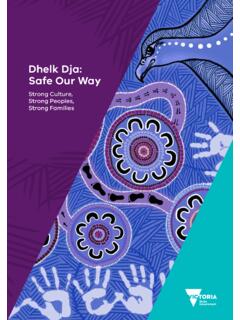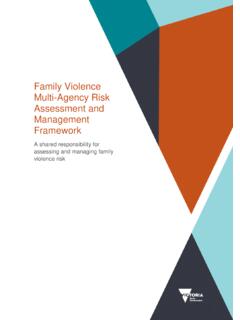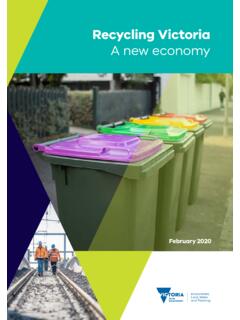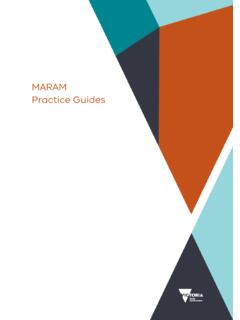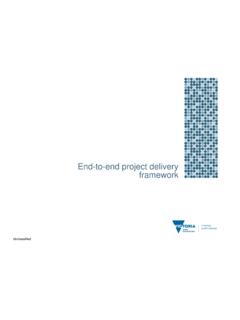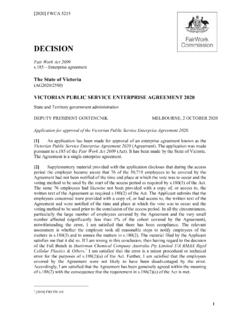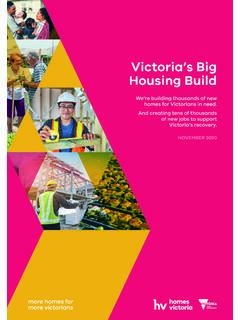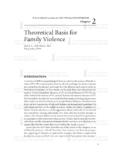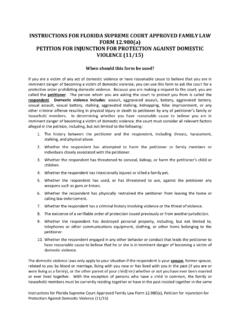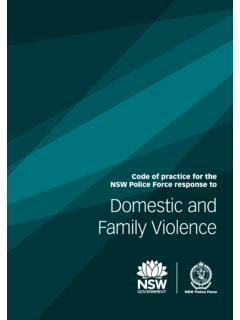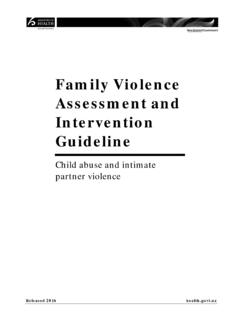Transcription of Responding to Family Violence Capability Framework
1 Responding to Family Violence Capability FrameworkDecember 2017 Aboriginal Acknowledgment The Victorian Government proudly acknowledges Victorian Aboriginal people as the first peoples and Traditional Owners and custodians of the land and water on which we rely. We acknowledge and respect that Aboriginal communities are steeped in traditions and customs built on an incredibly disciplined social and cultural order. This social and cultural order has sustained up to 50,000 years of existence. We acknowledge the ongoing leadership role of the Aboriginal community in addressing, and preventing Family Violence and join with our First Peoples to eliminate Family Violence from all ServicesIf you have experienced Family Violence or sexual assault and require immediate or ongoing assistance, contact 1800 RESPECT (1800 737 732) to talk to a counsellor from the National Sexual Assault and Domestic Violence hotline. 1800 RESPECT can also provide support to workers.
2 For confidential support and information, contact Safe Steps 24/7 Family Violence response line on 1800 015 188. If you are concerned for your safety or that of someone else, please contact the police in your state or territory or call 000 for emergency SCOPE ANDINTERSECTIONS WITH CURRENT EVIDENCE, POLICY AND . OF THIS Framework UNDERSTANDINGS UNDERPINNING EVIDENCE-BASED PRACTICEWHO IS THIS Framework FOR AND HOW CAN IT BE USED?RECOGNISING ABORIGINAL SELF-DETERMINATIONAN INTERSECTIONAL APPROACH TO Family Violence Family Violence AND SEXUAL ASSAULTA FOCUS ON CHILDREN AND YOUNG PEOPLE EXPOSED TO Family Violence INTERSECTION WITH THE Family Violence RISK ASSESSMENT AND RISK MANAGEMENT Framework REDEVELOPMENT INTERSECTION WITH THE PREVENTING Family Violence AND Violence AGAINST WOMEN Capability FRAMEWORK81011111212131394 CONTENTS34 WORKFORCES Responding TO Family VIOLENCEKNOWLEDGE AND SKILL OF THE WORKFORCE TIERSSTRUCTURE OF THIS Framework THE SPECIALIST Family Violence WORKFORCEFOUNDATIONAL KNOWLEDGE (ALL TIERS) KNOWLEDGE AND SKILLS FOR EACH Capability (TIERS 2-4)SPECIALIST KNOWLEDGE AND SKILLS FOR EACH Capability (TIER 1)141615171826 Responding to Family Violence Capability Framework / 5 INTRODUCTION1 Ending familyviolence:Victoria s planfor changeIn 2016 the Victorian Government released the guiding document, Ending Family Violence .
3 Victoria s Plan for Change (Plan for Change). This plan outlines a comprehensive understanding of Family Violence , including: Family Violence occurs when a perpetrator exercises power and control over another person. It involves coercive and abusive behaviours by the perpetrator that are designed to intimidate, humiliate, undermine and isolate; resulting in fear and insecurity. It covers a wide spectrum of conduct that involves an escalating spiral of Violence . These behaviours can include physical and sexual abuse, as well as psychological, emotional, cultural, spiritual and financial abuse. Although every experience is unique, Family Violence is not a one-off incident for most victim survivors. It is a pattern of behaviour that can occur over a long period of time. The Plan for Change acknowledges that: Whilst both men and women can be perpetrators or victims of Family Violence , overwhelmingly the majority of victim survivors are women and children, and the majority of perpetrators are men.
4 The most common and pervasive instances of Family Violence occur in intimate partner relationships, perpetrated by men against women. Family Violence takes many forms. It can occur within extended families, kinship networks, intergenerational relationships and through Family -like or carer relationships. Intimate partners, Family members and non- Family carers can perpetrate Violence against people with a disability. Young people can use Violence or be victims of Violence within their Family . Lesbian, gay, bisexual, trans and gender diverse and intersex people may experience Violence in their relationships or from Family members. Elder abuse can also be perpetrated by adult children of the victim or non- Family carers whilst people from diverse cultural, linguistic and faith backgrounds experience distinct forms of Family Violence , migration abuse and other forms of Violence including forced marriage and dowry-related abuse. In an Aboriginal context, factors contributing to Family Violence include the history of colonisation, dispossession of land and culture, spiritual and cultural abuse and the removal of children from their parents.
5 Family Violence is not part of Aboriginal culture, but intergenerational grief and trauma has resulted in the over-representation of Aboriginal people as victim survivors. Children and young people are also victims of Family Violence in their own right and are vulnerable due to their reliance on parents/carers to care for and protect them. Whether they experience Violence directly, or are exposed to Violence , the resulting trauma can affect their physical, emotional and psychological wellbeing. It also compromises their learning and development and has the potential to impact upon their future health and social outcomes. At its core, Family Violence is rooted in the inequality between women and men. This environment fosters discriminatory attitudes and behaviours that condone Violence and allow it to occur. For this reason, addressing gender inequality and discrimination is at the heart of preventing Family Violence , and other forms of Violence against women such as non-intimate partner sexual assault.
6 Whilst acknowledging the common elements of gendered Violence , it also acknowledges the circumstances of diverse individuals and communities, whose experiences of Violence are compounded by the multiple forms of discrimination and disadvantage that they , this Framework pays specific attention to the gendered nature of Family Violence and predominantly identifies capabilities associated with Responding to victim survivors or perpetrators of intimate partner Violence . It is acknowledged that if workforces have the capabilities to respond effectively to intimate partner Violence , it is likely that they will be equipped to respond to other forms of Family Violence given the core knowledge and skills required for Responding to a range of forms of Family Violence are similar. This Framework is the first iteration of a living Capability FRAMEWORKSTRUCTURE OF THE Capability FRAMEWORKE ngaging effectively with those accessing servicesIdentifying and assessing Family Violence riskManaging risk and prioritising safetyProviding effective servicesAdvocating for legislative, policy and practice Tier 1, the Capability Framework covers four levels of practice (entry-level to expert practitioner)
7 Tier 4 Tier 3 Tier 2 CapabilitiesFoundational KnowledgeTier 1 EntryMidSeniorExpertSpecialist Family Violence and sexual assault practitionersWorkers in core support or intervention agenciesWorkers in mainstream and non- Family Violence specific support agenciesWorkers in universal services and organisations 12345 FOUNDATIONAL KNOWLEDGER esponding to Family Violence Capability Framework / 7 This Framework is designed to articulate the skills required to work with adult, child and adolescent victim survivors of Family Violence , and to work with adult perpetrators of Family Violence . This Framework does not address the capabilities or standards required to undertake longer term therapeutic work such as counselling, psychological services and group work with victim survivors, perpetrators and children or other Family members impacted by Family Violence . It also does not address the skills required to work with victims of other forms of child abuse and neglect.
8 As a therapeutic lens has a role across intervention types from case management through to psychotherapy and counselling future iterations of this Framework may include longer term and recovery-oriented therapeutic work. The Framework currently incorporates a therapeutic lens as it functions within a crisis intervention and case management frame, also noting that various professionals and roles may provide support across a range of intervention types. This Framework also references current trauma-informed practice frameworks, and future iterations will seek to better understand and incorporate the role of a trauma-informed lens in the context of Family Violence including both current and future Framework aims to contribute to shaping the Family Violence workforce of the future. It is designed to span a 10-year period that is, it articulates the capabilities that workforces will need to achieve over the next decade if they are working with victim survivors or perpetrators of Family Framework supports the Building from Strength: 10-Year Industry Plan for Family Violence Prevention and Response (Industry Plan) released in December 2017 to provide a roadmap for workforce development and training to both prevent and respond to Family Violence and Violence against women and their children.
9 This Framework was developed alongside the Preventing Family Violence and Violence Against Women Capability Responding to Family Violence Capability Framework ( Framework ) provides the foundational skill set required to respond to all of forms of Family Violence . This Framework covers four workforce tiers spanning specialist Family Violence services, core support services and professionals, mainstream/social support services and universal services. 1 This Framework encompasses the following five capabilities required to ensure effective responses to victim survivors of Family Violence and perpetrators of Family Violence :The above capabilities are described for each workforce Tier, with an in-depth focus on the capabilities required for the specialist Family Violence effectively with those accessing services12345 Identifying and assessing Family Violence riskManaging risk and prioritising safety Providing effective servicesAdvocating for legislative, policy and practice reformAIM OF THE AIM OF THE FRAMEWORKC apabilities are the knowledge, skills and abilities required [by individuals] to perform their roles efficiently and effectively.
10 2 Learning and development encompasses a wide range of activities designed to improve the capabilities of people. A Capability Framework is an instrument to identify the critical factors or capabilities required now and in the future for high performance. 3 This Framework is designed to be applicable to a range of audiences and for a range of purposes. It will guide and support the development of the future workforce by: clearly articulating the knowledge and skills needed to respond to victim survivors of Family Violence (adults, children and young people) clearly articulating the knowledge and skills needed to intervene with perpetrators of Family Violence across sectors supporting a better understanding of Family Violence across sectors promoting better communication and team work in multidisciplinary projects by providing a common language and shared understanding of key concepts and practices shaping training and professional development programs and qualifications to align with the desired capabilities for Family Violence Framework will specifically support the specialist Family Violence sector by.


